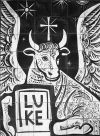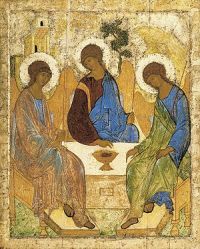
The Gospel of Luke
Jesus and Martha: Lk 10,38-42
This scene is about Jesus and Martha because it is between the two of them that all the action lies. Mary does nothing. Likewise, in the story of the raising of Lazarus in John 11, Mary sits at home while it is Martha who goes out to meet Jesus - that is when she accepts Jesus' teaching that he is the resurrection and the life (Jn 11,25-27). All Mary does is to criticise Jesus for not coming before her brother died (Jn 11,32). In John chapter 12, it is Martha who is serving the meal (Jn 12,2). What Mary does is to anoint Jesus' feet in preparation for his burial (Jn 12,7). In John's Gospel, Martha is not only as in Luke the active sister but she is also able to proclaim Jesus. Mary by contrast cannot see beyond the death of her brother nor the burial of Jesus. The two sisters as portrayed in the Gospel of John thus give us a wider perspective on the scene in Luke which we are now reading.
Here in Luke, all we are told about Mary in 9,40 is that she sat at the Lord's feet and listened to him - and this is the typical posture of discipleship.
Martha welcomed Jesus into her home (Mary it seems may be just another visitor) (10,38). In 9,11, before the feeding of the crowd, Jesus welcomed the crowds, a comment made only by Luke and not the other two evangelists. The message of hospitality is important both there and here. We may see this scene against the background of early Christian churches, based in houses ("household churches"). These it seems were often led by women such as Lydia (Acts 16,14-15) or Chloe (1 Cor 1,10).
It is usually assumed that Martha is serving a meal as in John 12,2 but nothing is said here about a meal. With the background I have just suggested, we can well see Martha's serving as part of the wider call to Christian service or ministry. That is why I have suggested Phoebe (Rom 1,16) at the end of the letter to the Romans as an example. (Phoebe is clearly called a deaconess though it is too early for that to imply an official position within the community as some would claim.)
Jesus is as always breaking boundaries: he is not supposed to be alone with women nor to be served by them nor is he supposed to be teaching them. Martha's appeal to Jesus in verse 40 turns Jesus into the dominant figure in the scene, perhaps making him the true host.
The majority of translations and the Greek New Testament have "there is need of only one thing" in verse 42. The Jerusalem Bible as used at Mass follows a less well supported version: "and few are needed, indeed only one". The first is preferrable because it makes the point more clearly.
It's not clear why Jesus gave such a sharp rebuke to Martha. Taking a wider picture, service is all important in the Christian community and service of the community is often stressed by Luke. We can though learn that to be a servant means becoming a listener first, the one thing needed in verse 42. We need to sit at the Lord's feet and then get up and serve. That's the lesson Martha had to learn from her sister's example.
That too is why we need to see this scene as complementary to the story of the Good Samaritan. The care shown by the Good Samaritan being the neighbour is not just an end in itself.
Back now to the main page .
The Sunday Gospel
The Genesis story of Abraham receiving the three men in the first ten verses of Genesis 18 is in the context of this Sunday's Gospel simply a story of hospitality: Abraham receives his visitors and provides for their needs in true oriental fashion. It assumes in the traditional way that Martha in the Gospel is preparing a meal for her visitor. There are overtones of something else happening in these ten verses, the son to be born to elderly parents. This is of course an important theme but not directly relevant to our Gospel.
If, however, the reading is extended to verse 15, then Abraham's wife Sarah becomes part of the episode. Her sceptical reaction to the promise of a son could be seen as adding to the background to the Gospel reading: Sarah needs to learn how to listen and to trust God.
Not to be forgotten is that this also is the scene of the famous icon of the Holy Trinity by Rublev:

Back now to the main page .
